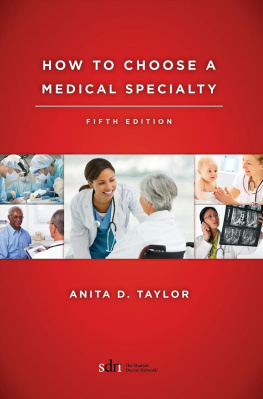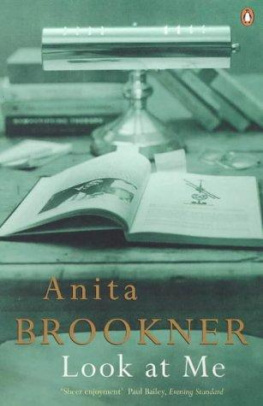How to Choose a Medical Specialty
Sixth Edition
Anita D. Taylor, M.A.Ed.
Associate Professor
Department of Family and Community Medicine
Eastern Virginia Medical School
Norfolk, Virginia
Associate Professor Emeritus
Department of Family Medicine
Oregon Health & Science University
School of Medicine
Portland, Oregon
Preface
Preface to the Sixth Edition
Welcome to the sixth edition of the book intended to help youmedical students throughout America and the worldchoose the medical specialty that is best for YOU. I wrote the first edition of this book in the early 1980s, at a time when medical students were apprehensive, and often emotional, as they faced choices related to their lifetime careers. There was then little information available on how to make an informed decision. New subspecialty options were emerging. With no curricular opportunities for clinical experience until their third-year clerkships, students lacked contact with physicians who might have been role models, and were often swayed by the sometimes biased opinions of family members, peers, and faculty. This book offered a guide on how to match ones individual skills, personality, and values with the work and culture of each of the medical specialties.
Today, well into the 21 st century, with the emergence of several new specialties and subspecialties as well as evolving roles in clinical and non-clinical settings, this book is needed more than ever. Medical schools struggle to provide informed career advising support as class sizes increase and other dutiesresearch and clinical carecompete for the time faculty traditionally spent teaching and mentoring medical students. There are multiple websites offering information of often questionable reliability, and most medical students continue to choose their careers with less than full information to guide one of the most important decisions of their lives. The sixth edition of this book can help fill in the blanks. It is the authoritative reference source for information on multiple specialties from the words of physicians in those areas of medicine.
Whats new in this sixth edition? There is updated information about 38 primary specialties and their subspecialties, including a new chapter on Interventional Radiology. The latest workforce predictions, compensation data, and specialty satisfaction ratings are presented for these specialties, as well as for the seven additional areas of emerging interest introduced in the fifth edition of the book. In the Planning for Residency Choice section of the book, I give information about the new agreement to institute a single Graduate Medical Education (GME) accreditation system for both M.D. and D.O. physicians. Other hot residency topics, such as the GME squeeze and the pressure to do audition rotations, that are causing increased stress for applicants are issues presented in this edition. Several newly invited medical students and residents, now in their training years, who served as my consultants for the chapters on the Military and Couples Matches share their experiences and offer timely advice.
In 1936, W. M. Johnson wrote, It is fortunate that there are so many different kinds of work for medical men to do, and equally fortunate that the same kind does not appeal to all alike. Eighty years later, with as many women as men in medical school, this is even more truethe challenge is to find what specialty will best suit you and how you can become this physician. May this book be your guide along the way.
Anita D. Taylor
1. Johnson WM. The True Physician: The Modern Doctor of the Old School. New York: MacMillan; 1936, p. 27.
how to choose a medical specialty ISBN 0-7216-7462-3
Copyright 2017, 2012, 2003, 2000, 1993, 1986 by Anita D. Taylor
All rights reserved. No part of this publication may be reproduced or transmitted in any form or by any means, electronic or mechanical, including photocopy, recording, or any information storage and retrieval system, without permission in writing from the publisher.
ISBN: 978-0-9979115-1-0 (ebook)
ISBN: 978-0-9979115-0-3 (print)
Printed in the United States of America
Last digit is the print number: 9 8 7 6 5 4 3 2 1
Library of Congress Cataloging-in-Publication Data
Taylor, Anita D.
How to choose a medical specialty / Anita D. Taylor. 6th2016ed.
p. cm.
Includes bibliographical references.
ISBN 0-7216-7462-3
1. MedicineSpecialties and specialists. I. Title.
[DNLM: 1. Career Choice. 2. Specialties, Medical.
W 90 T238h 2000]
R729.5.S6T38 2000
610.69dc21
DNLM/DLC
99-11899
Table of Contents
HOW TO USE THIS BOOK
The book is divided into five main sections. Part 1 has material discussing the challenges facing you as you choose a specialty and offers practical guidelines and worksheets to aid in decision making.
Part 2 gives comprehensive information on the specialties and subspecialties for which there is board certification approved by the American Board of Medical Specialties (ABMS). Each chapter gives factual information about the specialty and draws a composite picture of its practitioners. The composite is based on a questionnaire completed by physicians from a variety of geographic locations, types of practice settings, and professional backgrounds. An effort has been made to have representation from both male and female physicians in each field more or less in proportion to the actual numbers in that specialty, and to have contributors who are board certified in their specialty. There is a wide spectrum of ages, ranging from 29 to 75. The questions asked were suggested by medical students as pertinent in helping them to compare themselves with the practitioners of various specialties. To help you get the full benefit from this book, lets review the format of the chapters in Part 2.
At the beginning of each of the specialties chapters, Fast Facts gives statistical information on residency/fellowship training and physician data. There is publically available data and information from sources found online and in published articles in the medical literature, public newspapers, and magazines. Some of the information is from membership organizations:
- The December 8, 2015 Medical Education issue of the Journal of the American Medical Association
- 2015 American Board of Medical Specialties Guide to Medical Specialties
- Charting Outcomes in the Match, 5 th edition. Prepared by the NRMP, August 2014
- 2014 Census of Actively Licensed Physicians in the United States, Federation of State Boards
- 2014 Physician Specialty Data Book, Center for Workforce Studies, American Association of Medical Colleges, updated June 3, 2015
- American Medical Association Physician Masterfile, December 2013
- Results from the 2014 NRMP Program Director Survey. Green et al. in 2009 published data on this specific topic.
- American Medical of Medical Specialties (ABMS), 2012 certification statistics
- National Resident Matching Program data
General Information . Each chapter begins with a general description of the specialty, which may include historical data, information about the scope of activity, and commonly held beliefs about the specialty.
Residency Information . This section gives information about residency program requirements and training. When applicable, there is also information on fellowship training.
American Board of Medical Specialties Certification. Twenty-one primary and three conjoint examining and certifying boards issue certificates attesting to an individuals qualifications to practice a particular specialty. The primary objective of specialty boards is to assure the quality of medical education and care; the certificate issued is not to be confused with a medical degree, license, or legal document.









